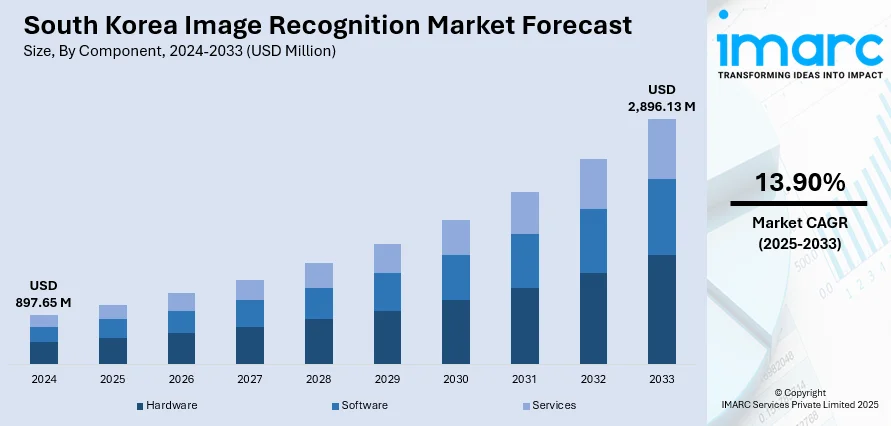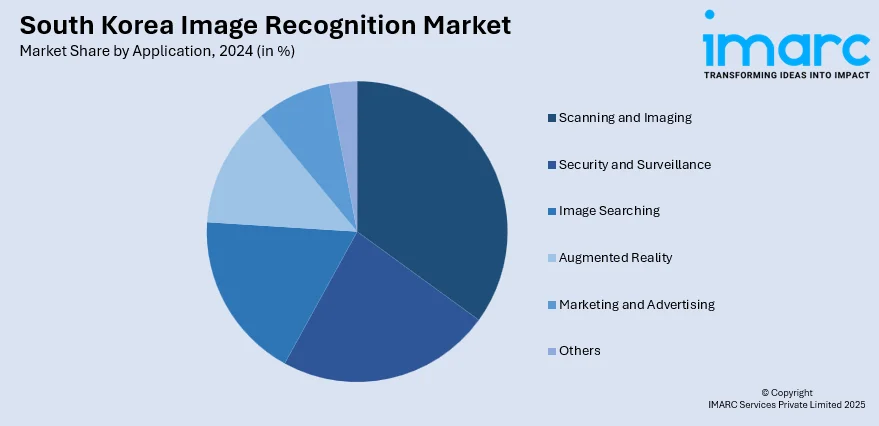
South Korea Image Recognition Market Size, Share, Trends and Forecast by Component, Technology, Application, Deployment Type, End Use Industry, and Region, 2025-2033
South Korea Image Recognition Market Overview:
The South Korea image recognition market size reached USD 897.65 Million in 2024. Looking forward, IMARC Group expects the market to reach USD 2,896.13 Million by 2033, exhibiting a growth rate (CAGR) of 13.90% during 2025-2033. Technological advancements in artificial intelligence (AI) and machine learning (ML), along with the rise of smart store technologies, are driving the image recognition market in South Korea. AI enhances precision and efficiency, while smart store solutions, like automated checkout and inventory management, are reshaping the retail sector, contributing to the expansion of the South Korea image recognition market share.
|
Report Attribute
|
Key Statistics
|
|---|---|
|
Base Year
|
2024 |
|
Forecast Years
|
2025-2033
|
|
Historical Years
|
2019-2024
|
| Market Size in 2024 | USD 897.65 Million |
| Market Forecast in 2033 | USD 2,896.13 Million |
| Market Growth Rate 2025-2033 | 13.90% |
South Korea Image Recognition Market Trends:
Technological Advancements in AI and ML
South Korea's retail sector is experiencing a major change, propelled by the emergence of smart store technologies that depend greatly on image recognition. Retailers are implementing creative solutions like smart shelves, automated payment systems, and in-store monitoring, all driven by image recognition, to improve operational efficiency and client satisfaction. These technologies enable stores without cashiers, allowing shoppers to grab items and exit without having to check out themselves. Moreover, image recognition is essential in inventory management, guaranteeing that shelves remain filled and products are recognized accurately. Retailers are progressively adopting these innovations to establish more technology-focused shopping experiences that meet the growing need for convenience and automation. A significant instance of this trend is the introduction of FacePay, a facial recognition payment system revealed in 2025 by South Korean convenience stores GS25, CU, and 7-Eleven. Created by Viva Republica, this system enables users to sign up via the Toss app and complete payments by scanning their face during checkout. Focusing on speed, privacy, and fraud protection, FacePay aims to transform the checkout procedure, improving the shopping experience. With South Korean retailers striving for enhanced and seamless individual experiences, image recognition technologies are crucial in transforming the retail sector, propelling market growth and establishing fresh benchmarks for convenience and effectiveness in shopping.

To get more information on this market, Request Sample
Growth in Retail and Smart Store Technologies
The retail sector in South Korea is experiencing a major change, fueled by the emergence of smart store technologies that largely depend on image recognition. Retailers are implementing cutting-edge solutions, including intelligent shelves, automated checkout kiosks, and in-store monitoring, all driven by image recognition technology, to improve operational efficiency and client satisfaction. These technologies enable cashier-free shops, allowing shoppers to grab products and exit without going through a manual checkout process. Moreover, image recognition is essential in inventory management, guaranteeing that shelves remain stocked and products are accurately identified. Retailers are progressively adopting these innovations to develop more technology-oriented shopping spaces that meet the rising need for convenience and automation. A significant instance of this trend is the debut of FacePay, a facial recognition payment platform revealed in 2025 by South Korean convenience stores GS25, CU, and 7-Eleven. This system, created by Viva Republica, enables users to sign up via the Toss app and complete payments by scanning their face during checkout. By focusing on speed, privacy, and fraud prevention, FacePay is poised to transform the checkout process, improving the shopping experience. These advancements are driving operational efficiency, enhancing client satisfaction, and setting new standards for convenience and automation, strengthening the South Korea image recognition market growth.
South Korea Image Recognition Market Segmentation:
IMARC Group provides an analysis of the key trends in each segment of the market, along with forecasts at the country and regional levels for 2025-2033. Our report has categorized the market based on component, technology, application, deployment type, and end use industry.
Component Insights:
- Hardware
- Software
- Services
The report has provided a detailed breakup and analysis of the market based on the component. This includes hardware, software, and services.
Technology Insights:
- Object Detection
- QR/Barcode Recognition
- Facial Recognition
- Pattern Recognition
- Optical Character Recognition
- Others
A detailed breakup and analysis of the market based on the technology have also been provided in the report. This includes object detection, QR/barcode recognition, facial recognition, pattern recognition, optical character recognition, and others.
Application Insights:

- Scanning and Imaging
- Security and Surveillance
- Image Searching
- Augmented Reality
- Marketing and Advertising
- Others
The report has provided a detailed breakup and analysis of the market based on the application. This includes scanning and imaging, security and surveillance, image searching, augmented reality, marketing and advertising, and others.
Deployment Type Insights:
- On-premises
- Cloud-based
A detailed breakup and analysis of the market based on the deployment type have also been provided in the report. This includes on-premises and cloud-based.
End Use Industry Insights:
- BFSI
- Media and Entertainment
- IT and Telecom
- Government
- Healthcare
- Transportation and Logistics
- Others
A detailed breakup and analysis of the market based on the end use industry have also been provided in the report. This includes BFSI, media and entertainment, IT and telecom, government, healthcare, transportation and logistics, and others.
Regional Insights:
- Seoul Capital Area
- Yeongnam (Southeastern Region)
- Honam (Southwestern Region)
- Hoseo (Central Region)
- Others
The report has also provided a comprehensive analysis of all the major regional markets, which include Seoul Capital Area, Yeongnam (Southeastern Region), Honam (Southwestern Region), Hoseo (Central Region), and others.
Competitive Landscape:
The market research report has also provided a comprehensive analysis of the competitive landscape. Competitive analysis such as market structure, key player positioning, top winning strategies, competitive dashboard, and company evaluation quadrant has been covered in the report. Also, detailed profiles of all major companies have been provided.
South Korea Image Recognition Market News:
- In May 2025, South Korea approved Meta’s opt-in facial recognition system to combat celebrity impersonation on Facebook. The system identifies and blocks unauthorized use of public figures' likenesses, aligning with strict privacy regulations. This move is part of Meta’s global strategy to fight fraud and improve digital identity verification.
- In April 2025, Korean researchers announced the development of Lp-convolution, an AI image recognition technology inspired by the brain’s visual cortex. This method helps AI prioritize key visual features, boosting accuracy without increasing computational load.
South Korea Image Recognition Market Report Coverage:
| Report Features | Details |
|---|---|
| Base Year of the Analysis | 2024 |
| Historical Period | 2019-2024 |
| Forecast Period | 2025-2033 |
| Units | Million USD |
| Scope of the Report | Exploration of Historical Trends and Market Outlook, Industry Catalysts and Challenges, Segment-Wise Historical and Future Market Assessment:
|
| Components Covered | Hardware, Software, Services |
| Technologies Covered | Object Detection, QR/Barcode Recognition, Facial Recognition, Pattern Recognition, Optical Character Recognition, Others |
| Applications Covered | Scanning and Imaging, Security and Surveillance, Image Searching, Augmented Reality, Marketing and Advertising, Others |
| Deployment Types Covered | On-premises, Cloud-based |
| End Use Industries Covered | BFSI, Media and Entertainment, IT and Telecom, Government, Healthcare, Transportation and Logistics, Others |
| Regions Covered | Seoul Capital Area, Yeongnam (Southeastern Region), Honam (Southwestern Region), Hoseo (Central Region), Others |
| Customization Scope | 10% Free Customization |
| Post-Sale Analyst Support | 10-12 Weeks |
| Delivery Format | PDF and Excel through Email (We can also provide the editable version of the report in PPT/Word format on special request) |
Key Questions Answered in This Report:
- How has the South Korea image recognition market performed so far and how will it perform in the coming years?
- What is the breakup of the South Korea image recognition market on the basis of component?
- What is the breakup of the South Korea image recognition market on the basis of technology?
- What is the breakup of the South Korea image recognition market on the basis of application?
- What is the breakup of the South Korea image recognition market on the basis of deployment type?
- What is the breakup of the South Korea image recognition market on the basis of end use industry?
- What is the breakup of the South Korea image recognition market on the basis of region?
- What are the various stages in the value chain of the South Korea image recognition market?
- What are the key driving factors and challenges in the South Korea image recognition market?
- What is the structure of the South Korea image recognition market and who are the key players?
- What is the degree of competition in the South Korea image recognition market?
Key Benefits for Stakeholders:
- IMARC’s industry report offers a comprehensive quantitative analysis of various market segments, historical and current market trends, market forecasts, and dynamics of the South Korea image recognition market from 2019-2033.
- The research report provides the latest information on the market drivers, challenges, and opportunities in the South Korea image recognition market.
- Porter's five forces analysis assist stakeholders in assessing the impact of new entrants, competitive rivalry, supplier power, buyer power, and the threat of substitution. It helps stakeholders to analyze the level of competition within the South Korea image recognition industry and its attractiveness.
- Competitive landscape allows stakeholders to understand their competitive environment and provides an insight into the current positions of key players in the market.
Need more help?
- Speak to our experienced analysts for insights on the current market scenarios.
- Include additional segments and countries to customize the report as per your requirement.
- Gain an unparalleled competitive advantage in your domain by understanding how to utilize the report and positively impacting your operations and revenue.
- For further assistance, please connect with our analysts.
 Request Customization
Request Customization
 Speak to an Analyst
Speak to an Analyst
 Request Brochure
Request Brochure
 Inquire Before Buying
Inquire Before Buying




.webp)




.webp)












